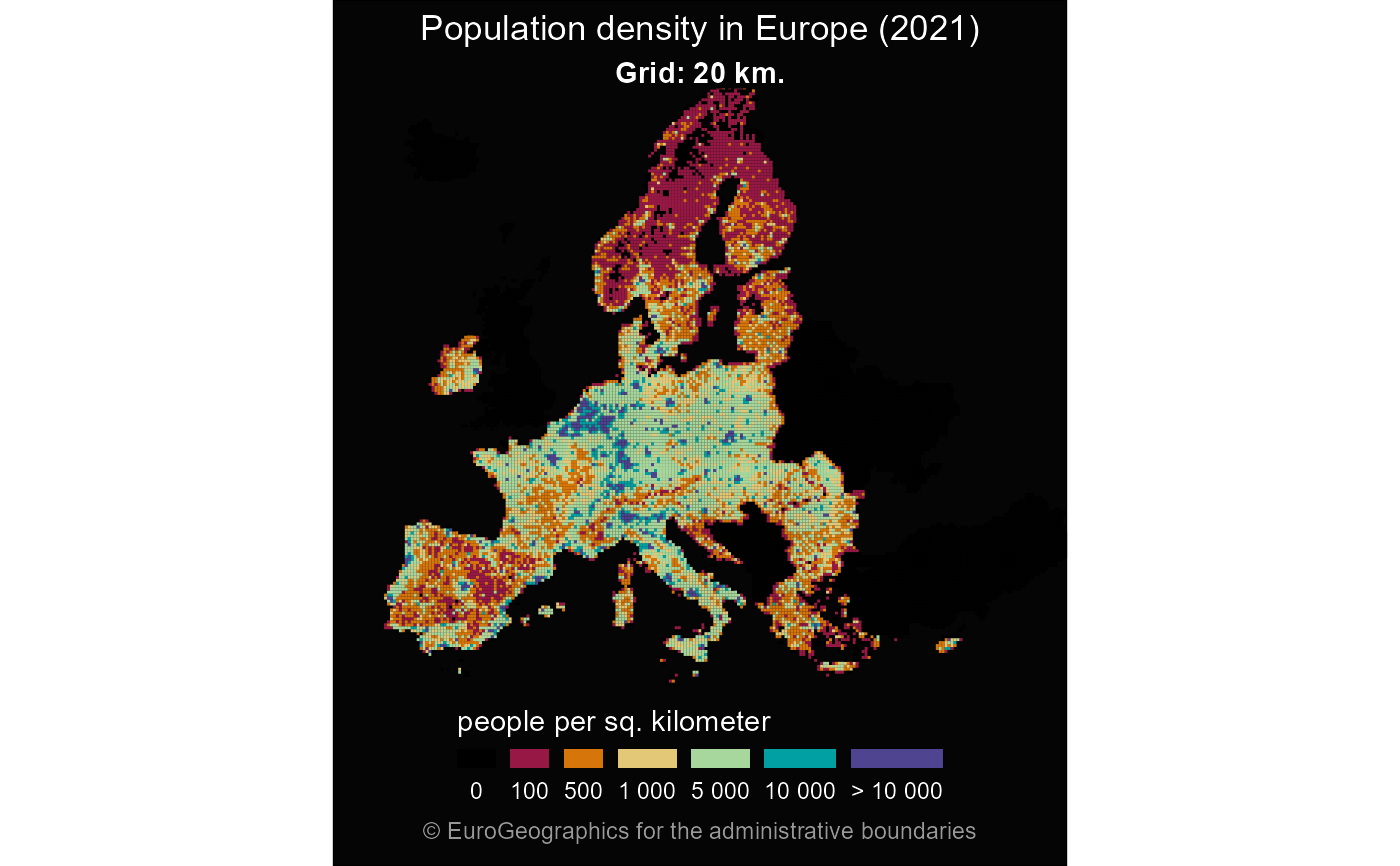
Get grid cells covering covering Europe for various resolutions
Source:R/gisco_get_grid.R
gisco_get_grid.RdThese datasets contain grid cells covering the European land territory, for various resolutions from 1km to 100km. Base statistics such as population figures are provided for these cells.
Usage
gisco_get_grid(
resolution = "20",
spatialtype = c("REGION", "POINT"),
cache_dir = NULL,
update_cache = FALSE,
verbose = FALSE
)Arguments
- resolution
Resolution of the grid cells on kms. Available values are
"1","2","5","10","20","50","100". See Details.- spatialtype
Select one of
"REGION"or"POINT".- cache_dir
A path to a cache directory. See About caching.
- update_cache
A logical whether to update cache. Default is
FALSE. When set toTRUEit would force a fresh download of the source.geojsonfile.- verbose
Logical, displays information. Useful for debugging, default is
FALSE.
Value
A POLYGON/POINT sf object.
Details
Files are distributed on EPSG:3035.
The file sizes range is from 428Kb (resolution = "100")
to 1.7Gb resolution = "1". For resolutions 1km and 2km you would
need to confirm the download.
Note
There are specific downloading provisions, please see https://ec.europa.eu/eurostat/web/gisco/geodata/grids
About caching
You can set your cache_dir with gisco_set_cache_dir().
Sometimes cached files may be corrupt. On that case, try re-downloading
the data setting update_cache = TRUE.
If you experience any problem on download, try to download the
corresponding .geojson file by any other method and save it on your
cache_dir. Use the option verbose = TRUE for debugging the API query.
For a complete list of files available check gisco_db.
Author
dieghernan, https://github.com/dieghernan/
Examples
# \donttest{
grid <- gisco_get_grid(resolution = 20)
# If downloaded correctly proceed
if (!is.null(grid)) {
library(dplyr)
grid <- grid %>%
mutate(popdens = TOT_P_2021 / 20)
breaks <- c(0, 0.1, 100, 500, 1000, 5000, 10000, Inf)
# Cut groups
grid <- grid %>%
mutate(popdens_cut = cut(popdens,
breaks = breaks,
include.lowest = TRUE
))
cut_labs <- prettyNum(breaks, big.mark = " ")[-1]
cut_labs[1] <- "0"
cut_labs[7] <- "> 10 000"
pal <- c("black", hcl.colors(length(breaks) - 2,
palette = "Spectral",
alpha = 0.9
))
library(ggplot2)
ggplot(grid) +
geom_sf(aes(fill = popdens_cut), color = NA, linewidth = 0) +
coord_sf(
xlim = c(2500000, 7000000),
ylim = c(1500000, 5200000)
) +
scale_fill_manual(
values = pal, na.value = "black",
name = "people per sq. kilometer",
labels = cut_labs,
guide = guide_legend(
direction = "horizontal",
nrow = 1
)
) +
theme_void() +
labs(
title = "Population density in Europe (2021)",
subtitle = "Grid: 20 km.",
caption = gisco_attributions()
) +
theme(
text = element_text(colour = "white"),
plot.background = element_rect(fill = "grey2"),
plot.title = element_text(hjust = 0.5),
plot.subtitle = element_text(hjust = 0.5, face = "bold"),
plot.caption = element_text(
color = "grey60", hjust = 0.5, vjust = 0,
margin = margin(t = 5, b = 10)
),
legend.position = "bottom",
legend.title.position = "top",
legend.text.position = "bottom",
legend.key.height = unit(0.5, "lines"),
legend.key.width = unit(1, "lines")
)
}
#>
#> Attaching package: 'dplyr'
#> The following objects are masked from 'package:stats':
#>
#> filter, lag
#> The following objects are masked from 'package:base':
#>
#> intersect, setdiff, setequal, union
 # }
# }